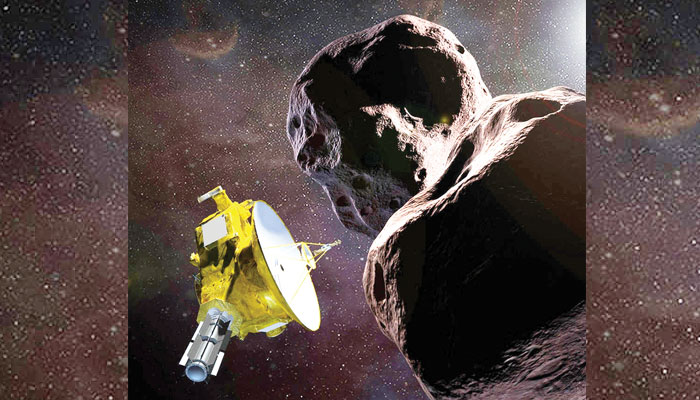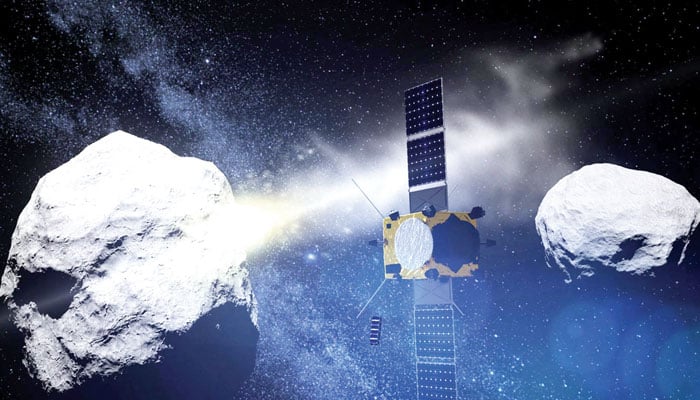Huzaifa Ahmed
Last month, the American space agency NASA destroyed one of its spacecraft by hitting an asteroid with great skill and success during an experiment in space. Through this mission, NASA wants to find out how difficult it can be to stop a large space rock from hitting the Earth. This experience of a spacecraft hitting a large stone in space has been conducted about one million kilometers away from the earth, the asteroid that the spacecraft was targeting. The experts named it “Demorphos”. While this mission is called “DART Mission”.
The American space agency NASA says that this space rock is not currently on a path or orbit to hit the Earth, nor will this experiment send this rock to Earth, when the NASA spacecraft collides with the asteroid. A camera on the spacecraft was filmed and photographed until it was destroyed. The spacecraft sent images of the entire experiment and every second of the asteroid’s impact journey back to Earth.
According to experts, the experiment was observed by other space telescopes including James Webb, the largest telescope in space. NASA is trying to figure out how to save Earth from a dangerous asteroid. One simple way, he thinks, is to crash the spacecraft into the asteroid. Its speed has to be reduced, so that the earth cannot become their target.

According to the preliminary calculations of the scientists, in this experiment, the spacecraft has hit only 17 meters away from the center of the asteroid. NASA experts say that we are starting a new era for humans. A period in which we might be able to protect ourselves from the impact of a dangerous asteroid. How amazing. We never had this capability before.
Dr. Elena Adams, mission system engineer at John Hopkins University’s Applied Physics Laboratory, says that this mission has been done as a theory experiment that a spacecraft from a 160-meter-wide asteroid called Demoforce will travel at a speed of about 20,000 to 22,000 kilometers. It is expected that after this experiment, this asteroid will begin to move a few minutes a day towards the orbit of a much larger asteroid called Didymos.
Scientists believe that as soon as the spacecraft collides with the 570-kg asteroid, the entire experiment will capture stunning images. Explaining this mission, Dr. Nancy Chabot of Johns Hopkins University’s Applied Physics Laboratory said that the Dart mission is the first defense experiment in space, in which a spacecraft is demonstrated to collide with an asteroid, so that it can be destroyed in space. The asteroid’s direction could be changed slightly. More than two dozen space telescopes on Earth observed the experiment and now they can precisely measure the distance between the orbits of the asteroids, called Dimorphos and Didymos. Will observe.

It’s a process where you can nudge an asteroid years in advance to slightly remove it from its orbit, in order to avoid collisions between the Earth and the asteroid in the future. Before this Dart mission, scientists had said that it would be very difficult for the spacecraft to target this asteroid called Dimorphos, because the NASA spacecraft in the last 50 minutes was able to distinguish between the 780-meter-wide asteroid Didymos and Dimorphos. will hit its original target.
After the mission was completed, he says everything went according to plan and the Dart mission hit its target by distinguishing between the asteroid Dimorphos and the asteroid Didymos. The navigation software on the spacecraft was designed to That the spacecraft should aim straight at its target while traveling. According to mission leader Dr. Andy Rivkin at Johns Hopkins University’s Applied Physics Laboratory, the program went exactly as planned.
NASA’s Dart mission scientist Dr. Tom A. Statler says that due to the speed and distance of light, it is not possible for a pilot to sit on the ground and control or operate this spacecraft. He added that We had to develop a software that could quickly analyze the images taken by this spacecraft, determine which one is the real target and take a direct path in pursuit of its target. During this mission, the spacecraft will send back to Earth every second of the action and scene as it moves towards the asteroid. And the asteroid that first appeared as a bright dot in these images will suddenly grow to cover the entire scene.
After that, the series of images will be interrupted at once, because at that time the spacecraft will have been destroyed by hitting the asteroid. The spacecraft involved in the Dart mission also launched an Italian-made 14-kilogram satellite into space a few months ago, with the aim of finding out what happens after Dart hits an asteroid. This satellite will record the entire process. This satellite will take pictures of the experiment from a distance of about 50 km during this mission and the pictures will be sent back to Earth during the next few days.
The satellite has been named “Lesia Cube” and Simone Perrotta of the Italian Space Agency says it will pass by about three minutes after Dart hits the asteroid. has been kept, because by that time the effects of the impact of the spacecraft on the asteroid will be completed and the impact will give time to change its orbit, because the second major function of the Lesia Cube satellite is To observe how much the spacecraft’s orbit changed after hitting the asteroid and how far it slipped from its orbit.
At this time, the asteroid Demoris completes its orbit around the asteroid Didymos in about 11 hours and 55 minutes. The experiment is expected to make a slight difference to its orbital period, and it will complete the orbit in 11 hours and 45 minutes, although confirmation of this measurement by space telescopes will take place over the next few weeks and months. Will be.
According to space surveys and statistical data, we have identified 95 percent of giant asteroids in space that could completely wipe out human life on Earth if they collided (but they might not). (Their orbits are calculated to not come close to the Earth.) But there are still many small asteroids in space that could wreak havoc after hitting the Earth, be it regional or city-level. But why not?
According to scientists, if an asteroid like Dimorphos were to hit the Earth (which it won’t), it could create a crater a kilometer wide and hundreds of meters deep, and the resulting shockwave would have a severe impact on nearby areas. can Four years from now, the European Space Agency will have three spacecraft, collectively called the HERA mission, investigating the aftermath of the experiment on Didymos and Dimorphos.
setTimeout(function(){
!function(f,b,e,v,n,t,s)
{if(f.fbq)return;n=f.fbq=function(){n.callMethod?
n.callMethod.apply(n,arguments):n.queue.push(arguments)};
if(!f._fbq)f._fbq=n;n.push=n;n.loaded=!0;n.version=’2.0′;
n.queue=[];t=b.createElement(e);t.async=!0;
t.src=v;s=b.getElementsByTagName(e)[0];
s.parentNode.insertBefore(t,s)}(window,document,’script’,
‘https://connect.facebook.net/en_US/fbevents.js’);
fbq(‘init’, ‘836181349842357’);
fbq(‘track’, ‘PageView’);
}, 6000);
/*setTimeout(function(){
(function (d, s, id) {
var js, fjs = d.getElementsByTagName(s)[0];
if (d.getElementById(id)) return;
js = d.createElement(s);
js.id = id;
js.src = “//connect.facebook.net/en_US/sdk.js#xfbml=1&version=v2.11&appId=580305968816694”;
fjs.parentNode.insertBefore(js, fjs);
}(document, ‘script’, ‘facebook-jssdk’));
}, 4000);*/


